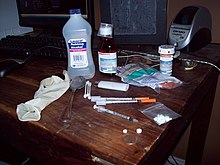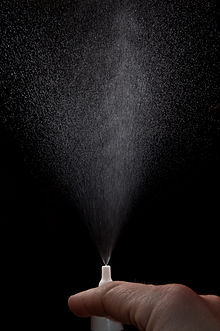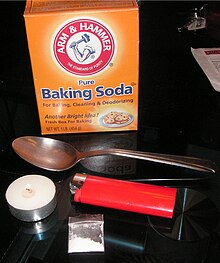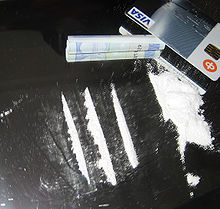
Recreational drug use is the use of one or more psychoactive drugs to induce an altered state of consciousness, either for pleasure or for some other casual purpose or pastime. When a psychoactive drug enters the user's body, it induces an intoxicating effect. Recreational drugs are commonly divided into three categories: depressants, stimulants, and hallucinogens.

A bong is a filtration device generally used for smoking cannabis, tobacco, or other herbal substances. In the bong shown in the photo, the smoke flows from the lower port on the left to the upper port on the right.

The prohibition of drugs through sumptuary legislation or religious law is a common means of attempting to prevent the recreational use of certain intoxicating substances.

A cannabis edible, also known as a cannabis-infused food or simply an edible, is a food item that contains decarboxylated cannabinoids from cannabis extract as an active ingredient. Although edible may refer to either a food or a drink, a cannabis-infused drink may be referred to more specifically as a liquid edible or drinkable. Edibles are a way to consume cannabis. Unlike smoking, in which cannabinoids are inhaled into the lungs and pass rapidly into the bloodstream, peaking in about ten minutes and wearing off in a couple of hours, cannabis edibles may take hours to digest, and their effects may peak two to three hours after consumption and persist for around six hours. The food or drink used may affect both the timing and potency of the dose ingested.

A head shop is a retail outlet specializing in paraphernalia used for consumption of cannabis and tobacco and items related to cannabis culture and related countercultures. They emerged from the hippie counterculture in the late 1960s, and at that time, many of them had close ties to the anti-Vietnam War movement as well as groups in the marijuana legalization movement like LeMar, Amorphia, and the National Organization for the Reform of Marijuana Laws.

A vaporizer or vaporiser, colloquially known as a vape, is a device used to vaporize substances for inhalation. Plant substances can be used, commonly cannabis, tobacco, or other herbs or blends of essential oil. However, they are most commonly filled with a combination propylene glycol, glycerin, and drugs such as nicotine or tetrahydrocannabinol as a liquid solution.

Cannabis, also known as marijuana or weed among other names, is a psychoactive drug from the cannabis plant. Native to Central or South Asia, the cannabis plant has been used as a drug for both recreational and entheogenic purposes and in various traditional medicines for centuries. Tetrahydrocannabinol (THC) is the main psychoactive component of cannabis, which is one of the 483 known compounds in the plant, including at least 65 other cannabinoids, such as cannabidiol (CBD). Cannabis can be used by smoking, vaporizing, within food, or as an extract.
A gravity bong, also known as a GB, bucket bong, grav, geeb, gibby, yoin, or ghetto bong, is a method of consuming smokable substances such as cannabis. The term describes both a bucket bong and a waterfall bong, since both use air pressure and water to draw smoke. A lung uses similar equipment but instead of water draws the smoke by removing a compacted plastic bag or similar from the chamber.
Lacing or cutting, in drug culture, refer to the act of using a substance to adulterate substances independent of the reason. The resulting substance is laced or cut.

Cannabis smoking is the inhalation of smoke or vapor released by heating the flowers, leaves, or extracts of cannabis and releasing the main psychoactive chemical, Δ9-tetrahydrocannabinol (THC), which is absorbed into the bloodstream via the lungs. Archaeological evidence indicates cannabis with high levels of THC was being smoked at least 2,500 years ago. As of 2021, cannabis is the most commonly consumed federally illegal drug in the United States, with 36.4 million people consuming it monthly.

A roach is the remains of a joint, blunt or roll up cigarette after most of it has been smoked. Most roaches are disposed of immediately after smoking a joint; however, some users will retain the roach for use at a later date. Some users maintain that smoking the roach again has a more intense high due to a high concentration of resin that gathers at the tip of the filter.

A one-hitter is typically a slender pipe with a screened narrow bowl designed for a single inhalation, or "hit", of smoke or vapor from a small serving of heated cannabis flower, tobacco leaf or other dry, sifted herbal preparation. It is distinguished from western-style large-bowl pipes designed for strong tobaccos that are burned hot and tasted but not inhaled. Instead, by properly distancing a lighter flame below the opening, inhalant users operate at vaporization temperatures, minimizing combustion waste and toxicity.

Spots refers to a method of smoking cannabis. Small pieces of cannabis are rolled to form the spot.

Cannabis consumption refers to the variety of ways cannabis is consumed, among which inhalation and ingestion are most common. All consumption methods involve heating the plant's THCA to decarboxylate it into THC, either at the time of consumption or during preparation. Salves and absorption through the skin (transdermal) are increasingly common in medical uses, both of CBD, THC, and other cannabinoids. Each method leads to subtly different psychoactive effects due to the THC and other chemicals being activated, and then consumed through different administration routes. It is generally considered that smoking, which includes combustion toxins, comes on quickly but lasts for a short period of time, while eating delays the onset of effect but the duration of effect is typically longer. In a 2007 ScienceDaily report of research conducted at the University of California–San Francisco, researchers reported that vaporizer users experience the same biological effect, but without the toxins associated with smoking. Δ9-THC is the primary component when inhaled, but when eaten the liver converts this to the more psychoactive 11-hydroxy-THC form.

Hash oil or cannabis oil is an oleoresin obtained by the extraction of cannabis or hashish. It is a cannabis concentrate containing many of its resins and terpenes – in particular, tetrahydrocannabinol (THC), cannabidiol (CBD), and other cannabinoids. Hash oil is usually consumed by smoking, vaporizing or eating. Preparations of hash oil may be solid or semi-liquid colloids depending on both production method and temperature and are usually identified by their appearance or characteristics. Color most commonly ranges from transparent golden or light brown, to tan or black. There are various extraction methods, most involving a solvent, such as butane or ethanol.
Hoffman Estates v. The Flipside, Hoffman Estates, Inc., 455 U.S. 489 (1982), is a United States Supreme Court decision concerning the vagueness and overbreadth doctrines as they apply to restrictions on commercial speech. The justices unanimously upheld an ordinance passed by a Chicago suburb that imposed licensing requirements on the sale of drug paraphernalia by a local record store. Their decision overturned the Seventh Circuit Court of Appeals.

Terms related to cannabis include:
Drug pipes are vessels used as drug paraphernalia to aid the smoking of hard drugs. They usually consist of a glass tube with or without a bulb, the latter particularly used when freebasing methamphetamine or crack cocaine.

The drug policy of Missouri involves the policies, measures and laws set by the government of Missouri to control substances.


























